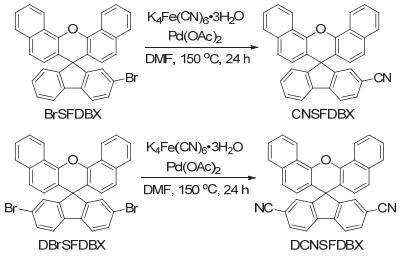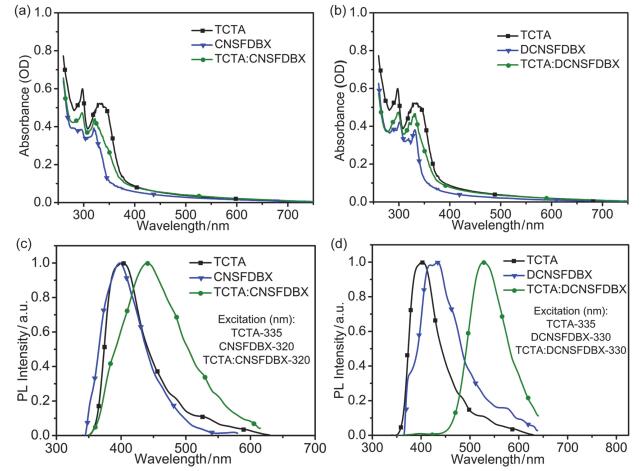-
[1]
Tang, C. W.; VanSlyke, S. A. Appl. Phys. Lett. 1987, 51, 913.
doi: 10.1063/1.98799
-
[2]
Baldo, M. A.; O'Brien, D. F.; You, Y.; Shoustikov, A.; Sibley, S.; Thompson, M. E.; Forrest, S. R. Nature 1998, 395, 151.
doi: 10.1038/25954
-
[3]
Kido, J.; Kimura, M.; Nagai, K. Science 1995, 267, 1332.
doi: 10.1126/science.267.5202.1332
-
[4]
Yu, J.; Xiao, Y.; Chen, J. Chin. J. Org. Chem. 2019, 39, 3460(in Chinese).
-
[5]
Zhang, T.; Qiu, Z.; Cheng, X.; Zhang, Y.; Wang, X. Chin. J. Org. Chem. 2019, 39, 2534(in Chinese).
-
[6]
Wang, T.; Hua, X.; Yu, Y.; Yuan, Y.; Feng, M.; Jiang, Z. Chin. J. Org. Chem. 2019, 39, 1436(in Chinese).
-
[7]
He, X.; Xiao, Y.; Yuan, X.; Ye, S.; Jiang, H. Chin. J. Org. Chem. 2019, 39, 761(in Chinese).
-
[8]
Wang, F.; Cao, X.; Mei, L.; Zhang, X.; Hu, J.; Tao, Y. Chinese J. Chem. 2018, 36, 241.
doi: 10.1002/cjoc.201700703
-
[9]
Lin, D.; Song, S.; Chen, Z.; Guo, P.; Chen, J.; Shi, H.; Mai, Y.; Song, H. Chin. J. Org. Chem. 2018, 38, 103(in Chinese).
-
[10]
Li, X.; Zhang, J.; Zhao, Z.; Wang, L.; Yang, H.; Chang, Q.; Jiang, N.; Liu, Z.; Bian, Z.; Liu, W.; Lu, Z.; Huang, C. Adv. Mater. 2018, 30, 1705005.
doi: 10.1002/adma.201705005
-
[11]
Klimes, K.; Zhu, Z.-Q.; Li, J. Adv. Funct. Mater. 2019, 29, 1903068.
doi: 10.1002/adfm.201903068
-
[12]
Kim, K.-H.; Kim, J.-J. Adv. Mater. 2018, 30, 1705600.
doi: 10.1002/adma.201705600
-
[13]
You, Y.; Park, S. Y. Dalton Trans. 2009, 1267.
-
[14]
Cheng, G.; Kwak, Y.; To, W.-P.; Lam, T.-L.; Tong, G. S. M.; Sit, M.-K.; Gong, S.; Choi, B.; Choi, W. i.; Yang, C.; Che, C.-M. ACS Appl. Mater. Interfaces 2019, 11, 45161.
doi: 10.1021/acsami.9b11715
-
[15]
Cao, H.; Shan, G.; Wen, X.; Sun, H.; Su, Z.; Zhong, R.; Xie, W.; Li, P.; Zhu, D. J. Mater. Chem. C 2013, 1, 7371.
doi: 10.1039/c3tc31365d
-
[16]
Endo, A.; Ogasawara, M.; Takahashi, A.; Yokoyama, D.; Kato, Y.; Adachi, C. Adv. Mater. 2009, 21, 4802.
doi: 10.1002/adma.200900983
-
[17]
Tao, Y.; Yuan, K.; Chen, T.; Xu, P.; Li, H.; Chen, R.; Zheng, C.; Zhang, L.; Huang, W. Adv. Mater. 2014, 26, 7931.
doi: 10.1002/adma.201402532
-
[18]
Liu, Y.; Li, C.; Ren, Z.; Yan, S.; Bryce, M. R. Nat. Rev. Mater. 2018, 3, 18020.
doi: 10.1038/natrevmats.2018.20
-
[19]
Nakagawa, T.; Ku, S.-Y.; Wong, K.-T.; Adachi, C. Chem. Commun. 2012, 48, 9580.
doi: 10.1039/c2cc31468a
-
[20]
Tanaka, H.; Shizu, K.; Miyazaki, H.; Adachi, C. Chem. Commun. 2012, 48, 11392.
doi: 10.1039/c2cc36237f
-
[21]
Wong, M. Y.; Zysman-Colman, E. Adv. Mater. 2017, 29, 1605444.
doi: 10.1002/adma.201605444
-
[22]
Sarma, M.; Wong, K.-T. ACS Appl. Mater. Interfaces 2018, 10, 19279.
doi: 10.1021/acsami.7b18318
-
[23]
Ng, T.-W.; Lo, M.-F.; Fung, M.-K.; Zhang, W.-J.; Lee, C.-S. Adv. Mater. 2014, 26, 5569.
doi: 10.1002/adma.201400563
-
[24]
Goushi, K.; Yoshida, K.; Sato, K.; Adachi, C. Nat. Photon. 2012, 6, 253.
doi: 10.1038/nphoton.2012.31
-
[25]
Li, J.; Nomura, H.; Miyazaki, H.; Adachi, C. Chem. Commun. 2014, 50, 6174.
doi: 10.1039/C4CC01590H
-
[26]
Liu, X.-K.; Chen, Z.; Zheng, C.-J.; Liu, C.-L.; Lee, C.-S.; Li, F.; Ou, X.-M.; Zhang, X.-H. Adv. Mater. 2015, 27, 2378.
doi: 10.1002/adma.201405062
-
[27]
Zhang, M.; Liu, W.; Zheng, C.-J.; Wang, K.; Shi, Y.-Z.; Li, X.; Lin, H.; Tao, S.-L.; Zhang, X.-H. Adv. Sci. 2019, 6, 1801938.
-
[28]
Chapran, M.; Pander, P.; Vasylieva, M.; Wiosna-Salyga, G.; Ulanski, J.; Dias, F. B.; Data, P. ACS Appl. Mater. Interfaces 2019, 11, 13460.
doi: 10.1021/acsami.8b18284
-
[29]
Cao, H.-T.; Zhao, Y.; Sun, C.; Fang, D.; Xie, L.-H.; Yan, M.-N.; Wei, Y.; Zhang, H.-M.; Huang, W. Dyes Pigm. 2018, 149, 422.
doi: 10.1016/j.dyepig.2017.10.019
-
[30]
Cao, H.-T.; Hong, C.-S.; Ye, D.-Q.; Liu, L.-H.; Xie, L.-H.; Chen, S.-F.; Sun, C.; Wang, S.-S.; Zhang, H.-M.; Huang, W. J. Mol. Struct. 2019, 1196, 132.
doi: 10.1016/j.molstruc.2019.06.003
-
[31]
Xie, L.-H.; Liu, F.; Tang, C.; Hou, X.-Y.; Hua, Y.-R.; Fan, Q.-L.; Huang, W. Org. Lett. 2006, 8, 2787.
doi: 10.1021/ol060871z
-
[32]
Ou, C.-J.; Ren, B.-Y.; Li, J.-W.; Lin, D.-Q.; Zhong, C.; Xie, L.-H.; Zhao, J.-F.; Mi, B.-X.; Cao, H.-T.; Huang, W. Org. Electron. 2017, 43, 87.
doi: 10.1016/j.orgel.2016.12.029
-
[33]
Ou, C.-J.; Zhu, C.; Ding, X.-H.; Yang, L.; Lin, J.-Y.; Xie, L.-H.; Qian, Y.; Xu, C.-X.; Zhao, J.-F.; Huang, W. J. Mater. Chem. C 2017, 5, 5345.
doi: 10.1039/C7TC00675F
-
[34]
Iwata, S.; Tanaka, J.; Nagakura, S. J. Chem. Phys. 1967, 47, 2203.
-
[35]
Gould, I. R.; Young, R. H.; Mueller, L. J.; Farid, S. J. Am. Chem. Soc. 1994, 116, 8176.
doi: 10.1021/ja00097a027
-
[36]
Kalinowski, J.; Giro, G.; Cocchi, M.; Fattori, V.; Di Marco, P. Appl. Phys. Lett. 2000, 76, 2352.
doi: 10.1063/1.126343
-
[37]
Uoyama, H.; Goushi, K.; Shizu, K.; Nomura, H.; Adachi, C. Nature 2012, 492, 234.
doi: 10.1038/nature11687
-
[38]
Wu, T.-L.; Liao, S.-Y.; Huang, P.-Y.; Hong, Z.-S.; Huang, M.-P.; Lin, C.-C.; Cheng, M.-J.; Cheng, C.-H. ACS Appl. Mater. Interfaces 2019, 11, 19294.
doi: 10.1021/acsami.9b04365

 Login In
Login In







 DownLoad:
DownLoad:



